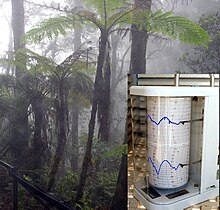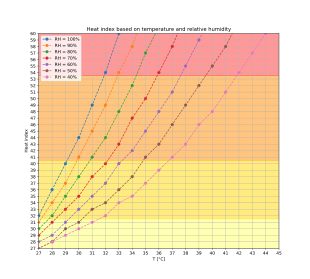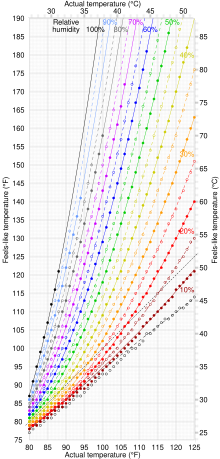Heat index
| Humidity and hygrometry |
|---|
 |
| Specific concepts |
| General concepts |
| Measures and instruments |
The heat index (HI) is an index that combines air temperature and relative humidity, in shaded areas, to posit a human-perceived equivalent temperature, as how hot it would feel if the humidity were some other value in the shade. The result is also known as the "felt air temperature", "apparent temperature", "real feel" or "feels like".[citation needed] For example, when the temperature is 32 °C (90 °F) with 70% relative humidity, the heat index is 41 °C (106 °F). The humidity where the heat index feels like itself is typically left unstated. The heat index example in this case, 41°C, feels like 41°C only when the relative humidity is 21%.
The human body normally cools itself by perspiration, or sweating. Heat is removed from the body by evaporation of that sweat. However, high relative humidity reduces the evaporation rate. This results in a lower rate of heat removal from the body, hence the sensation of being overheated. This effect is subjective, with different individuals perceiving heat differently for various reasons (such as differences in body shape, metabolic differences, differences in hydration, pregnancy, menopause, effects of drugs or drug withdrawal); its measurement has been based on subjective descriptions of how hot subjects feel for a given temperature and humidity. This results in a heat index that relates one combination of temperature and humidity to another.
Because the heat index is based on temperatures in the shade, while people often move across sunny areas, the heat index can give a much lower temperature than actual conditions of typical outdoor activities. Also, for people exercising or active, at the time, then the heat index could give a temperature lower than the felt conditions.[citation needed]
History
The heat index was developed in 1979 by Robert G. Steadman.[1][2] Like the wind chill index, the heat index contains assumptions about the human body mass and height, clothing, amount of physical activity, individual heat tolerance, sunlight and ultraviolet radiation exposure, and the wind speed. Significant deviations from these will result in heat index values which do not accurately reflect the perceived temperature.[3]
In Canada, the similar humidex (a Canadian innovation introduced in 1965)[4] is used in place of the heat index. While both the humidex and the heat index are calculated using dew point, the humidex uses a dew point of 7 °C (45 °F) as a base, whereas the heat index uses a dew point base of 14 °C (57 °F).[further explanation needed] Further, the heat index uses heat balance equations which account for many variables other than vapor pressure, which is used exclusively in the humidex calculation. A joint committee [who?] formed by the United States and Canada to resolve differences has since been disbanded. [citation needed]
Definition
The heat index of a given combination of (dry-bulb) temperature and humidity is defined as the dry-bulb temperature which would feel the same if the water vapor pressure were 1.6 kPa. Quoting Steadman, "Thus, for instance, an apparent temperature of 24 °C (75 °F) refers to the same level of sultriness, and the same clothing requirements, as a dry-bulb temperature of 24 °C (75 °F) with a vapor pressure of 1.6 kPa."[1]
This vapor pressure corresponds for example to an air temperature of 29 °C (84 °F) and relative humidity of 40% in the sea-level psychrometric chart, and in Steadman's table at 40% RH the apparent temperature is equal to the true temperature between 26–31 °C (79–88 °F). At standard atmospheric pressure (101.325 kPa), this baseline also corresponds to a dew point of 14 °C (57 °F) and a mixing ratio of 0.01 (10 g of water vapor per kilogram of dry air).[1]
A given value of relative humidity causes larger increases in the heat index at higher temperatures. For example, at approximately 27 °C (81 °F), the heat index will agree with the actual temperature if the relative humidity is 45%, but at 43 °C (109 °F), any relative-humidity reading above 18% will make the heat index higher than 43 °C.[5]
It has been suggested that the equation described is valid only if the temperature is 27 °C (81 °F) or more.[6] The relative humidity threshold, below which a heat index calculation will return a number equal to or lower than the air temperature (a lower heat index is generally considered invalid), varies with temperature and is not linear. The threshold is commonly set at an arbitrary 40%.[5]
The heat index and its counterpart the humidex both take into account only two variables, shade temperature and atmospheric moisture (humidity), thus providing only a limited estimate of thermal comfort. Additional factors such as wind, sunshine and individual clothing choices also affect perceived temperature; these factors are parameterized as constants in the heat index formula. Wind, for example, is assumed to be 5 knots (9.3 km/h).[5] Wind passing over wet or sweaty skin causes evaporation and a wind chill effect that the heat index does not measure. The other major factor is sunshine; standing in direct sunlight can add up to 15 °F (8.3 °C) to the apparent heat compared to shade.[7] There have been attempts to create a universal apparent temperature, such as the wet-bulb globe temperature, "relative outdoor temperature", "feels like", or the proprietary "RealFeel".
Meteorological considerations
Outdoors in open conditions, as the relative humidity increases, first haze and ultimately a thicker cloud cover develops, reducing the amount of direct sunlight reaching the surface. Thus, there is an inverse relationship between maximum potential temperature and maximum potential relative humidity. Because of this factor, it was once believed that the highest heat index reading actually attainable anywhere on Earth was approximately 71 °C (160 °F). However, in Dhahran, Saudi Arabia on July 8, 2003, the dew point was 35 °C (95 °F) while the temperature was 42 °C (108 °F), resulting in a heat index of 81 °C (178 °F).[8]
The human body requires evaporative cooling to prevent overheating. Wet-bulb temperature, and Wet Bulb Globe Temperature are used to determine the ability of a body to eliminate excess heat. A sustained wet-bulb temperature of about 35 °C (95 °F) can be fatal to healthy people; at this temperature our bodies switch from shedding heat to the environment, to gaining heat from it.[9] Thus a wet bulb temperature of 35 °C (95 °F) is the threshold beyond which the body is no longer able to adequately cool itself.[10]
Table of values
The table below is from the U.S. National Oceanic and Atmospheric Administration. The columns begin at 80 °F (27 °C), but there is also a heat index effect at 79 °F (26 °C) and similar temperatures when there is high humidity.
Temperature Relative humidity
|
80 °F (27 °C) | 82 °F (28 °C) | 84 °F (29 °C) | 86 °F (30 °C) | 88 °F (31 °C) | 90 °F (32 °C) | 92 °F (33 °C) | 94 °F (34 °C) | 96 °F (36 °C) | 98 °F (37 °C) | 100 °F (38 °C) | 102 °F (39 °C) | 104 °F (40 °C) | 106 °F (41 °C) | 108 °F (42 °C) | 110 °F (43 °C) |
|---|---|---|---|---|---|---|---|---|---|---|---|---|---|---|---|---|
| 40% | 80 °F (27 °C) | 81 °F (27 °C) | 83 °F (28 °C) | 85 °F (29 °C) | 88 °F (31 °C) | 91 °F (33 °C) | 94 °F (34 °C) | 97 °F (36 °C) | 101 °F (38 °C) | 105 °F (41 °C) | 109 °F (43 °C) | 114 °F (46 °C) | 119 °F (48 °C) | 124 °F (51 °C) | 130 °F (54 °C) | 136 °F (58 °C) |
| 45% | 80 °F (27 °C) | 82 °F (28 °C) | 84 °F (29 °C) | 87 °F (31 °C) | 89 °F (32 °C) | 93 °F (34 °C) | 96 °F (36 °C) | 100 °F (38 °C) | 104 °F (40 °C) | 109 °F (43 °C) | 114 °F (46 °C) | 119 °F (48 °C) | 124 °F (51 °C) | 130 °F (54 °C) | 137 °F (58 °C) | |
| 50% | 81 °F (27 °C) | 83 °F (28 °C) | 85 °F (29 °C) | 88 °F (31 °C) | 91 °F (33 °C) | 95 °F (35 °C) | 99 °F (37 °C) | 103 °F (39 °C) | 108 °F (42 °C) | 113 °F (45 °C) | 118 °F (48 °C) | 124 °F (51 °C) | 131 °F (55 °C) | 137 °F (58 °C) | ||
| 55% | 81 °F (27 °C) | 84 °F (29 °C) | 86 °F (30 °C) | 89 °F (32 °C) | 93 °F (34 °C) | 97 °F (36 °C) | 101 °F (38 °C) | 106 °F (41 °C) | 112 °F (44 °C) | 117 °F (47 °C) | 124 °F (51 °C) | 130 °F (54 °C) | 137 °F (58 °C) | |||
| 60% | 82 °F (28 °C) | 84 °F (29 °C) | 88 °F (31 °C) | 91 °F (33 °C) | 95 °F (35 °C) | 100 °F (38 °C) | 105 °F (41 °C) | 110 °F (43 °C) | 116 °F (47 °C) | 123 °F (51 °C) | 129 °F (54 °C) | 137 °F (58 °C) | ||||
| 65% | 82 °F (28 °C) | 85 °F (29 °C) | 89 °F (32 °C) | 93 °F (34 °C) | 98 °F (37 °C) | 103 °F (39 °C) | 108 °F (42 °C) | 114 °F (46 °C) | 121 °F (49 °C) | 128 °F (53 °C) | 136 °F (58 °C) | |||||
| 70% | 83 °F (28 °C) | 86 °F (30 °C) | 90 °F (32 °C) | 95 °F (35 °C) | 100 °F (38 °C) | 105 °F (41 °C) | 112 °F (44 °C) | 119 °F (48 °C) | 126 °F (52 °C) | 134 °F (57 °C) | ||||||
| 75% | 84 °F (29 °C) | 88 °F (31 °C) | 92 °F (33 °C) | 97 °F (36 °C) | 103 °F (39 °C) | 109 °F (43 °C) | 116 °F (47 °C) | 124 °F (51 °C) | 132 °F (56 °C) | |||||||
| 80% | 84 °F (29 °C) | 89 °F (32 °C) | 94 °F (34 °C) | 100 °F (38 °C) | 106 °F (41 °C) | 113 °F (45 °C) | 121 °F (49 °C) | 129 °F (54 °C) | ||||||||
| 85% | 85 °F (29 °C) | 90 °F (32 °C) | 96 °F (36 °C) | 102 °F (39 °C) | 110 °F (43 °C) | 117 °F (47 °C) | 126 °F (52 °C) | 135 °F (57 °C) | ||||||||
| 90% | 86 °F (30 °C) | 91 °F (33 °C) | 98 °F (37 °C) | 105 °F (41 °C) | 113 °F (45 °C) | 122 °F (50 °C) | 131 °F (55 °C) | |||||||||
| 95% | 86 °F (30 °C) | 93 °F (34 °C) | 100 °F (38 °C) | 108 °F (42 °C) | 117 °F (47 °C) | 127 °F (53 °C) | ||||||||||
| 100% | 87 °F (31 °C) | 95 °F (35 °C) | 103 °F (39 °C) | 112 °F (44 °C) | 121 °F (49 °C) | 132 °F (56 °C) |
For example, if the air temperature is 96 °F (36 °C) and the relative humidity is 65%, the heat index is 121 °F (49 °C)
Effects of the heat index (shade values)

| Celsius | Notes |
|---|---|
| 27–32 °C | Caution: fatigue is possible with prolonged exposure and activity. Continuing activity could result in heat cramps. |
| 32–41 °C | Extreme caution: heat cramps and heat exhaustion are possible. Continuing activity could result in heat stroke. |
| 41–54 °C | Danger: heat cramps and heat exhaustion are likely; heat stroke is probable with continued activity. |
| over 54 °C | Extreme danger: heat stroke is imminent. |
Exposure to full sunshine can increase heat index values by up to 8 °C (14 °F).[11]
Formula

There are many formulas devised to approximate the original tables by Steadman. Anderson et al. (2013),[12] NWS (2011), Jonson and Long (2004), and Schoen (2005) have lesser residuals in this order. The former two are a set of polynomials, but the third one is by a single formula with exponential functions.
The formula below approximates the heat index in degrees Fahrenheit, to within ±1.3 °F (0.7 °C). It is the result of a multivariate fit (temperature equal to or greater than 80 °F (27 °C) and relative humidity equal to or greater than 40%) to a model of the human body.[1][13] This equation reproduces the above NOAA National Weather Service table (except the values at 90 °F (32 °C) & 45%/70% relative humidity vary unrounded by less than ±1, respectively). where
- HI = heat index (in degrees Fahrenheit)
- T = ambient dry-bulb temperature (in degrees Fahrenheit)
- R = relative humidity (percentage value between 0 and 100)
The following coefficients can be used to determine the heat index when the temperature is given in degrees Celsius, where
- HI = heat index (in degrees Celsius)
- T = ambient dry-bulb temperature (in degrees Celsius)
- R = relative humidity (percentage value between 0 and 100)
An alternative set of constants for this equation that is within ±3 °F (1.7 °C) of the NWS master table for all humidities from 0 to 80% and all temperatures between 70 and 115 °F (21–46 °C) and all heat indices below 150 °F (66 °C) is:
A further alternate is this:[14] where
For example, using this last formula, with temperature 90 °F (32 °C) and relative humidity (RH) of 85%, the result would be: Heat index for 90 °F, RH 85% = 114.9.
Limitations
The heat index does not work well with extreme conditions, like supersaturation of air-- when the air is more than 100% saturated with water. David Romps, a physicist and climate scientist at the University of California, Berkeley and his graduate student Yi-Chuan Lu, found that the heat index was underestimating the severity of intense heat waves, such as 1995 Chicago heat wave. Other issues with the heat index include unavailability of precise humidity data in many geographical regions, assumption that the person is healthy and has easy access to water and shade.[15]
See also
- Apparent temperature
- Thermal comfort § Interplay of temperature and humidity
- Humidex
- Wet-bulb temperature
- Wind chill
References
- ^ a b c d Steadman, R. G. (July 1979). "The Assessment of Sultriness. Part I: A Temperature-Humidity Index Based on Human Physiology and Clothing Science". Journal of Applied Meteorology. 18 (7): 861–873. Bibcode:1979JApMe..18..861S. doi:10.1175/1520-0450(1979)018<0861:TAOSPI>2.0.CO;2.
- ^ Steadman, R. G. (July 1979). "The Assessment of Sultriness. Part II: Effects of Wind, Extra Radiation and Barometric Pressure on Apparent Temperature". Journal of Applied Meteorology. 18 (7): 874–885. Bibcode:1979JApMe..18..874S. doi:10.1175/1520-0450(1979)018<0874:TAOSPI>2.0.CO;2.
- ^ "How do they figure the heat index? - By Daniel Engber - Slate Magazine". Archived from the original on 2011-06-21. Retrieved 2008-02-01.
- ^ "Spring and Summer Hazards". Environment and Climate Changes. Government of Canada. Retrieved 2016-09-22.
- ^ a b c Heat index calculator and conversion table from iWeatherNet
- ^ Heat Index Campbell Scientific Inc. Archived 2010-05-25 at the Wayback Machine (PDF file), CampbellSci.com.
- ^ Heat Index from the National Weather Service. "exposure to full sunshine can increase heat index values by up to 15°F."
- ^ "This Saudi city could soon face unprecedented and unlivable heat levels". Business Insider. Retrieved 2017-07-20.
- ^ Sherwood, S.C.; Huber, M. (25 May 2010). "An adaptability limit to climate change due to heat stress". Proc. Natl. Acad. Sci. U.S.A. 107 (21): 9552–5. Bibcode:2010PNAS..107.9552S. doi:10.1073/pnas.0913352107. PMC 2906879. PMID 20439769.
- ^ Dunne, John P.; Stouffer, Ronald J.; John, Jasmin G. (2013). "Heat stress reduces labor capacity under climate warming". Geophysical Fluid Dynamics Laboratory. 3 (6): 563. Bibcode:2013NatCC...3..563D. doi:10.1038/nclimate1827.
- ^ Heat Index on the website of the Pueblo, CO United States National Weather Service.
- ^ Anderson, G. Brooke; Bell, Michelle L.; Peng, Roger D. (2013). "Methods to Calculate the Heat Index as an Exposure Metric in Environmental Health Research". Environmental Health Perspectives. 121 (10): 1111–1119. doi:10.1289/ehp.1206273. PMC 3801457. PMID 23934704.
- ^ Lans P. Rothfusz. "The Heat Index 'Equation' (or, More Than You Ever Wanted to Know About Heat Index)", Scientific Services Division (NWS Southern Region Headquarters), 1 July 1990 [1]
- ^ Stull, Richard (2000). Meteorology for Scientists and Engineers, Second Edition. Brooks/Cole. p. 60. ISBN 9780534372149.
- ^ Barber, Gregory. "The US Is Measuring Extreme Heat Wrong". Wired. Retrieved 2022-09-21.
External links
- Description of wind chill & apparent temperature Formulae in metric units
- Heat Index Calculator Calculates both °F and °C
- Current map of global heat index values






